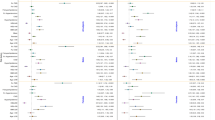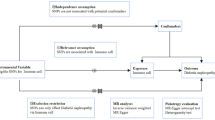Abstract
Worldwide prevalence of diabetes mellitus motivates a number of association studies to be conducted throughout the world. Eleven polymorphisms from nine candidate genes in oxidative stress pathway have been analyzed in eastern Indian type 2 diabetic patients (n = 145) and healthy controls (n = 100). Different biochemical parameters were also analyzed for their association with the disease. Significant associations were observed for rs2070424 A>G SOD1 (OR 3.91, 95% CI 2.265–8.142, P < 0.001), rs854573 A>G PON1 (OR 3.415, 95% CI 2.116–5.512, P < 0.001), rs6954345 G>C PON2 (OR 3.208, 95% CI 2.071–4.969, P < 0.001), RAGE rs1800624 −374 T>A (OR 3.58, 95% CI 2.218–5.766, P < 0.001), and NOS3 −786 T>C (OR 3.75, 95% CI 2.225–6.666, P < 0.001). Haplotype containing two risk alleles of PON1 and PON2 genes was significantly associated with disease (OR 8.34, 95% CI 1.554–44.804, P < 0.002). Our results suggest that carriers of major and efficient alleles of oxidative stress genes are more likely to survive the comorbid complications and single copy of risk allele is sufficient for developing the disease.






Similar content being viewed by others
References
Adak S, Sengupta S, Chowdhury S, Bhattacharyya M (2010) Co existence of risk and protective haplotypes of Calpain 10 gene to type 2 diabetes in the eastern Indian population. Diab Vasc Dis Res 7:63–68
Agrawal S, Tripathi G, Prajnya R, Sinha N, Gilmour A, Bush L, Mastana S (2009) Paraxonase 1 gene polymorphisms contribute to coronary artery disease risk among north Indians. Ind J Med Sci 63:335–344
Altuner D, Suzen SH, Ates I, Koc GV, Aral Y et al (2011) Are PON1 Q/R 192 and M/L 55 polymorphisms risk factors for diabetes complications in Turkish population? Clin Biochem 44:372–376
Banerjee M, Saxena M (2012) An overview and molecular genetics of type 2 diabetes mellitus. In: Caplis I, Frangopoulos S (eds) Type 2 diabetes mellitus: causes, treatment and preventive strategies. Nova Science Publishers, New York
Baragetti I, Norata D, Sarcina C et al (2013) 374 T/A RAGE polymorphism is associated with chronic kidney disease progression in subjects affected by nephrocardiovascular disease. PLoS One 8:e0060089
Brownlee M (2001) Biochemistry and molecular cell biology of diabetic complications. Nature 414:813–820
Chen H, Li X, Epstein PN (2005) MnSOD and catalase transgenes demonstrate that protection of islets from oxidative stress does not alter cytokine toxicity. Diabetes 54:1437–1446
Costa LG, Cole TB, Jarvik GP, Furlong CE (2003) Functional genomics of the paraoxonase (PON1) polymorphisms: effects on pesticide sensitivity, cardiovascular disease, and drug metabolism. Annu Rev Med 54:371–392
DeFronzo RA (1997) Pathogenesis of type 2 diabetes: metabolic and molecular implications for identifying diabetes genes. Diabetes Rev 5:177–269
Del Prato S, Marchetti P (2004) Beta and alpha-cell dysfunction in type 2 diabetes. Horm Metab Res 36:775–781
Donaghue KC, Margan SH, Chan AK, Holloway B, Silink M, Rangel T, Bennetts B (2005) The association of aldose reductase gene (AKR1B1) polymorphisms with diabetic neuropathy in adolescents. Diabet Med 22:1315–1320
Ergun MA, Yurtcu E, Demirci H, Ilhan MN, Barkar V et al (2011) PON1 55 and 192 gene polymorphisms in type 2 diabetes mellitus patients in a Turkish population. Biochem Genet 49:1–8
Haber CA, Lam TK, Yu Z, Gupta N, Goh T, Bogdanovic E, Giacca A, Fantus IG (2003) N-acetylcysteine and taurine prevent hyperglycemia-induced insulin resistance in vivo: possible role of oxidative stress. Am J Physiol Endocrinol Metab 285:E744–E753
Kankova K, Sebekova K (2005) Genetic variability in the RAGE gene: possible implications for nutrigenetics, nutrigenomics, and understanding the susceptibility to diabetic complications. Mol Nutr Food Res 49:700–709
King GL, Loeken MR (2004) Hyperglycemia-induced oxidative stress in diabetic complications. Histochem Cell Biol 122:333–338
Koya D, King GL (1998) Protein kinase C activation and the development of diabetic complications. Diabetes 47:859–866
Leon CA, Raij L (2005) Interaction of haemodynamic and metabolic pathways in the genesis of diabetic nephropathy. J Hypertens 23:1931–1937
Maiese K, Morhan SD, Chong ZZ (2007) Oxidative stress biology and cell injury during type 1 and type 2 diabetes mellitus. Curr Neurovasc Res 4:63–71
Makiishi T, Araki S, Koya D, Maeda S, Kashiwagi A, Haneda M (2003) C-106T polymorphism of AKR1B1 is associated with diabetic nephropathy and erythrocyte aldose reductase content in Japanese subjects with type 2 diabetes mellitus. Am J Kidney Dis 42:943–951
Matsunaga-Irie S, Maruyama T, Yamamoto Y et al (2004) Relation between development of nephropathy and the p22phox C242T and receptor for advanced glycation end product G1704T gene polymorphisms in type 2 diabetic patients. Diabet Care 27:303–307
Mayer B, Hemmens B (1997) Biosynthesis and action of nitric oxide in mammalian cells. Trends Biochem Sci 22:477–481
McGarry JD (2002) Banting Lecture 2001. Dysregulation of fatty acid metabolism in the etiology of type 2 diabetes. Diabetes 51:7–18
Miller SA, Dykes DD, Polesky HF (1988) A simple salting out procedure for extracting DNA from human nucleated cells. Nucleic Acids Res 16(3):1215
Moore DJ, Gregory JM, Kumah-crystal YA, Simmons JH (2009) Mitigating micro- and macro-vascular complications of diabetes beginning in adolescence. Vasc Health Risk Manag 5:1015–1031
Nishikawa T, Edelstein D, Du XL, Yamagishi S, Matsumura T, Kaneda Y, Yorek MA, Beebe D, Oates PJ, Hammes HP, Giardino I, Brownlee M (2000) Normalizing mitochondrial superoxide production blocks three pathways of hyperglycaemic damage. Nature 404:787–790
Poitout V, Robertson RP (2002) Secondary beta-cell failure in type 2 diabetes—a convergence of glucotoxicity and lipotoxicity. Endocrinology 143:339–342
Prasad P, Tiwari AK, Prasanna K, Ammini AC, Gupta A, Gupta R, Thelma BK (2010) Association analysis of ADPRT1, AKR1B1, RAGE, GFPT2 and PAI-1 gene polymorphisms with chronic renal insufficiency among Asian Indians with type-2 diabetes. BMC Med Genet 11:52
Rachek LI, Thornley NP, Grishko VI, LeDoux SP, Wilson GL (2006) Protection of INS-1 cells from free fatty acid-induced apoptosis by targeting hOGG1 to mitochondria. Diabetes 55:1022–1028
Ramprasad S, Radha V, Mathias RA, Majumder PP, Rao MRS, Rema M (2007) RAGE gene promoter polymorphisms and diabetic retinopathy in a clinic-based population from South India. Eye 21:395–401
Ray Haldar S, Bhattacharyya M (2014) Lipid peroxidation products as predictors in disease progression. J Exp Integr Med 4:151–164
Richter RJ, Jarvik GP, Furlong CE (2010) Paraoxonase 1 status as a risk factor for disease or exposure. Adv Exp Med Biol 660:29–35
Rosen P, Nawroth PP, King G, Moller W, Tritschler HJ, Packer L (2001) The role of oxidative stress in the onset and progression of diabetes and its complications: a summary of a Congress Series sponsored by UNESCOMCBN, the American Diabetes Association, and the German Diabetes Society. Diabetes Metab Res Rev 17:189–212
Shadman Z, Khoshniat M, Poorsoltan N et al (2013) Association of high carbohydrate versus high fat diet with glycated haemoglobin in high calorie consuming type 2 diabetics. J Diabetes Metab Disord 12:27
Sheetz MJ, King GL (2002) Molecular understanding of hyperglycemia’s adverse effects for diabetic complications. J Am Med Assoc 288:2579–2588
Sivenius K, Niskanen L, Voutilainen-Kaunisto R, Laakso M, Uusitupa M (2004) Aldose reductase gene polymorphisms and susceptibility to microvascular complications in Type 2 diabetes. Diabet Med 21:1325–1333
Stevens MJ, Obrosova I, Feldman EL, Greene DA (2000) The sorbitol-osmotic and sorbitol-redox hypothesis. In: LeRoith D, Taylor SI, Olefsky JM (eds) Diabetes mellitus: a fundamental and clinical text. Lippincott Williams & Wilkins, Philadelphia
Tanus-Santos JE, Desai M, Flockhart DA (2001) Effect of ethnicity on the distribution of clinically relevant endothelial nitric oxide variants. Pharmacogenetics 11:719–725
Thameem F, Puppala S, Arar NH, Stern MP, Blangero J, Duggirala R, Abboud HE (2008) Endothelial nitric oxide synthase (eNOS) gene polymorphisms and their association with type 2 diabetes-related traits in Mexican Americans. Diab Vasc Dis Res 5:109–113
Tiwari AK, Prasad P, Thelma BK, Prasanna Kumar KM, Ammini AC, Gupta A, Gupta R (2009) Oxidative stress pathway genes and chronic renal insufficiency in Asian Indians with Type 2 diabetes. J Diabetes Complicat 23:102–111
Wang Y, Ng MC, Lee SC, So WY, Tong PC, Cockram CS, Critchley JA, Chan JC (2003) Phenotypic heterogeneity and associations of two aldose reductase gene polymorphisms with nephropathy and retinopathy in type 2 diabetes. Diabetes Care 26:2410–2415
Wild S, Roglic G, Green A, Sicree R, King H (2004) Global prevalence of diabetes: estimates for the year 2000 and projections for 2030. Diabetes Care 27:1047–1053
Wolff SP, Dean RT (1987) Glucose autoxidation and protein modification: the potential role of autoxidative glycosylation’ in diabetes. Biochem J 245:243–250
Yano M, Hasegawa G, Ishii M, Yamasaki M, Fukui M, Nakamura N, Yoshikawa T (2004) Short-term exposure of high glucose concentration induces generation of reactive oxygen species in endothelial cells: implication for the oxidative stress associated with postprandial hyperglycemia. Redox Rep 9:111–116
Acknowledgments
We acknowledge Dr. D. S. Kothari Fellowship Scheme, UGC for providing fellowship to the first author. We are grateful to UGC-CAS, DST-FIST, World bank ICZM funding in Dept. of Biochemistry for providing infrastructure and instrumental facilities. We feel our heartfelt gratitude to Prof. Saugata Sen Roy, Dept. of Statistics, C. U. for his continuous assistance in statistical aspects. We are grateful to all of the patients and volunteer donors for providing their blood sample to us; we regret our inability to mention them individually.
Conflict of interest
The authors report no conflicts of interest.
Author information
Authors and Affiliations
Corresponding authors
Rights and permissions
About this article
Cite this article
Haldar, S.R., Chakrabarty, A., Chowdhury, S. et al. Oxidative Stress-Related Genes in Type 2 Diabetes: Association Analysis and Their Clinical Impact. Biochem Genet 53, 93–119 (2015). https://doi.org/10.1007/s10528-015-9675-z
Received:
Accepted:
Published:
Issue Date:
DOI: https://doi.org/10.1007/s10528-015-9675-z




